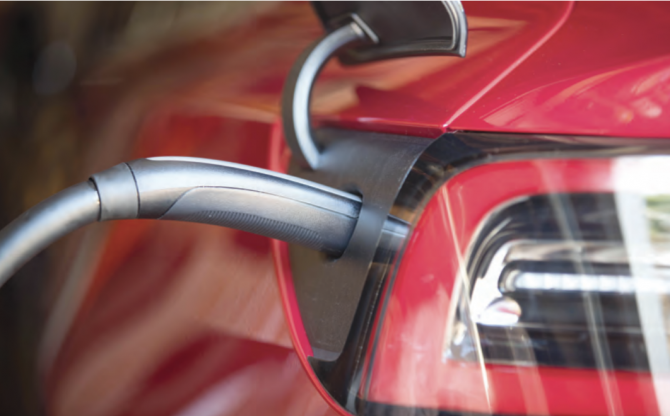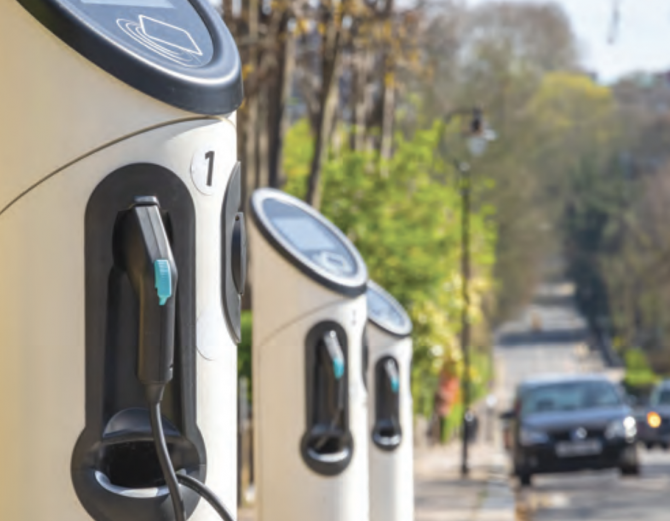
Coating electric vehicle charging stations for safer, tougher reliability
By Calvin Jennings, senior director automotive, HZO
Automation / Robotics Electronics Interconnect Power Supply / Management Production / Materials charging Editor Pick electric epoxy EVSE materials Parylene production resin silicone stations vehiclesWhich conformal coating has the best chemical composition to deliver all attributes & operational function?
The emergence and development of electric vehicles (EVs) have consumers around the globe switching to electric mobility. The BBC recently reported that 20% of all new cars sold globally will be electric by 2025. EVs have finally attained mainstream status, and sales are beginning to overtake those of internal combustion vehicles. And there are solid reasons for doing so. No fuel means no emissions. This is particularly important for those interested in decreasing their impact on the environment through transport. Running costs are minimal, as are maintenance costs. Where performance was once an issue, there is hardly an automobile manufacturer that has not jumped on the EV bandwagon. The competition has rocketed EV performance.
However, there continue to be perceived and real technical barriers to the widespread adoption of electric vehicles. The availability and reliability of a fast-charging infrastructure continue to be the major hurdle. Although home charging is where most electric vehicle charging happens, long-distance driving requires a ubiquitous network of working charging stations to make long-distance travel feasible. According to Deloitte, as of February 2021, there were almost 100,000 charging outlets for plug-in electric vehicles (EVs) in the United States. Regardless of where charging takes place, charging stations can fail – and when they do, drivers become stranded.

Source: Adobe Images
Electric Vehicle Supply Equipment (EVSE), commonly called charging stations or charging docks, supplies electric energy to recharge electric vehicles. They are designed and manufactured into the EV charging standard for electrical safety for the user, the vehicle, and the power grid. Several residential and commercial ac and dc EVSEs configurations are designed to deliver a range of power outputs, load capabilities, and offer different connector types. North America, Europe, and China have regional standards, and some are vendor-specific, like Tesla. Regardless of the differences, all EVSEs have components that enable them to perform the same essential functions.
Charging stations are typically housed in National Electrical Manufacturers Association (NEMA) rated enclosures with either a box on the charging cable, a wall-mounted unit, or a tower. Ac power flows into the chamber through a plug for portable units or a hardwired connection for permanently placed units. A cable runs from the enclosure with a connector that connects to the vehicle’s charging port. In Direct Current Fast Charging (DCFC,) the EVSE enclosure also contains components that convert ac power to dc.
Indicating whether the cable is connected correctly
The internal components of an EVSE consist of a power source, three-phase electric power, charging points, masters, a server and database, asynchronous serial connections, communication TCP/IP (Transmission Control Protocol/Internet Protocol), and slaves. There is the main relay for switching power to the vehicle on or off and a module that controls the main relay. When in use, there are high voltage connector terminals for charging and pilot connectors for a low voltage connection to the EVSE’s control module. When a connection is made, the control module assesses power levels on the pilot connectors, indicating whether the cable is connected correctly and whether there is a ground fault. It also verifies that the vehicle’s systems are ready to receive a charge and the charging station is ready to deliver power. The main relay then powers up the cable connected to the EV.

Source: Adobe Images
Although there are many different EVSE configurations, all the connectors have pins that enable basic functions. More sophisticated charging stations contain microcontrollers that can be programmed to perform specific tasks such as adjusting power output, monitoring charging progress, connecting to the Internet, and interacting with mobile apps that enable users to control the charging station remotely.
Charging stations are typically located outside, which makes them vulnerable to external sources. They are susceptible to voltage transients or electrical surges resulting from a sudden release of energy previously stored or induced by heavy inductive loads or lightning. Being outside also means the delicate internal components are susceptible to the elements. To compound the issue, in-network EVSE failures can impact other chargers or transmit across power lines and affect other electrical power equipment.
Protecting EVSEs is with conformal coatings
The realistic and economical approach to protecting EVSEs is with conformal coatings, polymeric film-forming products that protect circuit boards, components, and other electronic devices from adverse environmental conditions. As the name implies, they conform to the structure and environment of the items being coated, thereby providing increased dielectric resistance, operational integrity, and protection from corrosive atmospheres and contaminants, including humidity, heat and cold, mold, dirt, and dust.

Source: Adobe Images
The question is – which conformal coating? The chemical composition of each determines its attributes and operational function. Acrylic Resin – Acrylic conformal coating provides fair elasticity and general protection – or what is considered basic, entry-level protection. It is recognized for high dielectric strength and adequate moisture and abrasion resistance. Acrylic is easy to apply and remove, making rework and field repair practical and economical. Still, it does not protect against solvents and vapors, making it less than ideal for many applications.
Silicone Resin – Silicone conformal coating is moisture, chemical, salt spray, and fungal resistant, making it appropriate for high-humidity environments. As a soft and flexible solder-through coating, it has good dielectric properties that can withstand wide temperature ranges. Its rubbery nature makes it unresistant to abrasion, but this property makes it resilient against vibrational stresses. This quality makes removal a challenge, requiring specialized solvents, long soak time, and agitation from a brush or an ultrasonic bath.
Urethane (Polyurethane) Resin – Urethane conformal coating is known for excellent moisture, chemical, solvent, and abrasion resistance. It is challenging to remove. They are applied as single or two-component formulas with claims of suitability for printed circuit boards.
Epoxy Resin – Epoxy resin conformal coating is usually available as a two‐part compound and creates a very hard coating. It enjoys humidity resistance and is not generally permeable. It has high abrasion and chemical resistance, which makes removal very difficult once cured.
Parylene – Parylene, with its unique chemistry, and deep molecular reach, has emerged as the conformal coating of choice for various industries, including automotive, medical, aerospace, military, industrial, and consumer electronics. When compared to acrylic, silicones, urethane, and epoxy coatings, Parylene has all the properties and characteristics necessary to help advance technologies. There is no liquid phase with Parylene, and it is truly conformal. It can create a uniform controllable thickness that is entirely pinhole-free at thicknesses greater than 0.5 µm, even for the most intricate and complex shapes. This ultra-thin coating can penetrate spaces as narrow as 0.01mm.

Source: Adobe Images
Parylene is inert, insoluble, thermally stable between -200°C and 125°C and higher, has a dielectric strength of 7 kV/mil, and has high elasticity with an elongation break of 200%. It acts as a dry film lubricant, eliminates the need for liquid release agents, and protects from a range of contaminants, including moisture, corrosive fluids, chemicals, gases, and fungus.
Parylene is applied near room temperature, which means any object that can be exposed to medium vacuum can be coated. Overall, its distinctive properties can be used to provide protection solutions to a wide variety of applications. Manufacturers are often amazed at the sheer number of items that can be effectively coated with Parylene.
As the barriers to electric vehicle adoption are removed, they are increasingly becoming a realistic and viable transportation option. They are nothing, however, without reliable charging stations. The automotive industry routinely turns to Parylene coatings to provide enhanced protection for all kinds of electronic circuitry. With so many automakers preparing to move away from combustion and hybrid-powered vehicles to full EVs, EVSEs will be held to the same durability and dependability standards consumers expect in their vehicles.
——————————-
Calvin Jennings joined HZO with more than 20 years of experience in the automotive electronic business working for such companies as Ford, Visteon, Continental, and HBPO. Jennings worked in many areas of the automotive industry, from manufacturing and design engineering at Ford to business development and sales at Visteon, Continental, and HBPO. Jennings holds a B.S. in Electrical Engineering from Widener University and an MBA from the University of Michigan, Ross School of Business.
